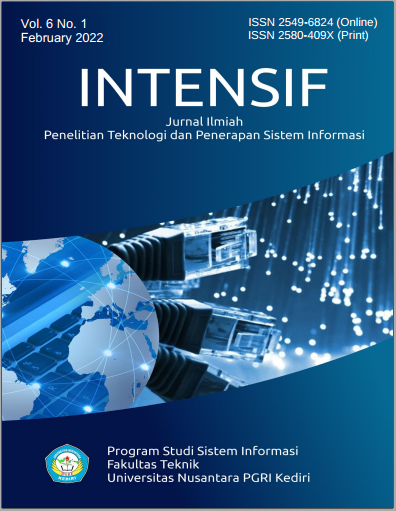Fuzzy Method Design for IoT-Based Mushroom Greenhouse Controlling
DOI:
https://doi.org/10.29407/intensif.v6i1.16786Keywords:
Fuzzy, Mushroom, Internet of ThingsAbstract
The ideal conditions for the oyster mushrooms growth are at a humidity of 65-75% and 29-31C during incubation, while the growth of stems should be at a humidity of 70-90% 29-32C. This ideal ecosystem is maintained by aeration and manual watering. Still, the results are not optimal in preventing damage to the mycelium during the incubation period, resulting in a decrease in crop yields. Automatic control has not created ideal conditions because air temperature and humidity regulation are only based on fans and sprayers that do not directly affect air conditions. Therefore, we need a method to manipulate the mushroom greenhouse space ecosystem, namely fuzzy logic, the application of fuzzy logic integrated with sensors, actuators, and microcontrollers with the Internet of Things to solve this problem. The results of the installation of fuzzy logic in the mushroom's greenhouse in this system can be seen from the fan's modulation response and the pump's duration. The test results of this control feature can manipulate temperature and humidity. Therefore, the oyster mushroom greenhouse produces an ideal state of 29.8C, the humidity of 68.97% RH, and the production has been proven to be optimal with an average daily harvest of 3.8kg.
Downloads
References
F. I. Ubaidillah, I. Istiadi, and M. Mukhsim, “Sistem Pemantauan Dan Pengendalian Rumah Jamur Dengan Metode Fuzzy Secara Wireless,” Simetris J. Tek. Mesin, Elektro dan Ilmu Komput., vol. 11, no. 1, pp. 223–232, 2020, doi: 10.24176/simet.v11i1.3975.
F. Masykur, A. Prasetyo, I. Widaningrum, A. F. Cobantoro, and M. B. Setyawan, "Application of Message Queuing Telemetry Transport (MQTT) Protocol in the Internet of Things to Monitor Mushroom Cultivation," in 2020 7th International Conference on Information Technology, Computer, and Electrical Engineering (ICITACEE), 2020, pp. 135–139, doi: 10.1109/ICITACEE50144.2020.9239118.
P. Indraja, M. Madhava, S. Satyam, P. R. Chandra, and S. J. Prince, "Cultivation of Milky Mushroom (Calocybeindica) in Greenhouse," Curr. J. Appl. Sci. Technol., vol. 40, no. 9, pp. 63–69, 2021, doi: 10.9734/cjast/2021/v40i931348.
N. S. Devi, D. Erwanto, and Y. B. Utomo, “Perancangan Sistem Kontrol Suhu Dan Kelembaban Pada Ruangan Budidaya Jamur Tiram Berbasis IoT,” Multitek Indones., vol. 12, no. 2, p. 104, 2018, doi: 10.24269/mtkind.v12i2.1331.
N. Ritha and R. Wardoyo, “Implementasi Neural Fuzzy Inference System dan Algoritma Pelatihan Levenberg-Marquardt untuk Prediksi Curah Hujan,” IJCCS (Indonesian J. Comput. Cybern. Syst., vol. 10, no. 2, p. 125, 2016, doi: 10.22146/ijccs.15532.
T. Kaewwiset and P. Yodkhad, "Automatic temperature and humidity control system by using Fuzzy Logic algorithm for mushroom nursery," in 2017 International Conference on Digital Arts, Media and Technology (ICDAMT), 2017, pp. 396–399, doi: 10.1109/ICDAMT.2017.7905000.
F. Rozie, I. Syarif, M. U. H. Al Rasyid, and E. Satriyanto, “Sistem Akuaponik untuk Peternakan Lele dan Tanaman Kangkung Hidroponik Berbasis IoT dan Sistem Inferensi Fuzzy,” J. Teknol. Inf. dan Ilmu Komput., vol. 8, no. 1, p. 157, 2021, doi: 10.25126/jtiik.0814025.
H. Fitriawan, K. A. D. Cahyo, S. Purwiyanti, and S. Alam, “Pengendalian Suhu dan Kelembaban pada Budidaya Jamur Tiram Berbasis IoT,” J. Tek. Pertan. Lampung (Journal Agric. Eng., vol. 9, no. 1, p. 28, 2020, doi: 10.23960/jtep-l.v9i1.28-37.
F. Fahmizal, T. R. Orlando, B. B. Murti, M. Budiyanto, and A. Mayub, “Kendali Logika Fuzzy pada Sistem Electronic Control Unit (ECU) Air Conditioner Mobil,” J. Teknol. Inf. dan Ilmu Komput., vol. 6, no. 1, p. 25, 2019, doi: 10.25126/jtiik.2019611045.
J. Ilmiah and M. Indonesia, “Multitekq,” vol. 10, no. 1, pp. 48–56, 2016.
M. K. Ardi, B. D. Setiawan, and M. A. Fauzi, “Optimasi Fuzzy Inference System Tsukamoto Menggunakan Algoritme Genetika Untuk Mengetahui Lama Waktu Siram Pada Tanaman Strawberry variabel kelembaban merupakan nilai yang didapatkan dari hasil percobaan menggunakan sensor yang mana sensor ini nantinya me,” J. Pengemb. Teknol. Inf. dan Ilmu Komput. Univ. Brawijaya, vol. 2, no. 10, 2018.
E. Nuraharjo et al., “PENDEKATAN LOGIKA FUZZY TSUKAMOTO UNTUK,” pp. 978–979, 2020.
A. Prasetyo and A. R. Yusuf, “Integrated Device Electronic Untuk Sistem Irigasi Tetes Dengan Kendali Internet of Things,” J. Ilm. Teknol. Inf. Asia, vol. 14, no. 1, p. 1, 2019, doi: 10.32815/jitika.v14i1.361.
A. Prasetyo, “Purwarupa Internet of Things Sistem Kewaspadaan,” vol. 3, no. 3, pp. 201–205, 2018.
M. B. Setyawan, A. F. Cobantoro, A. Prasetyo, P. S. Informatika, F. Teknik, and U. M. Ponorogo, “Prototype Untuk Monitoring Presensi Siswa Menggunakan,” vol. 13, no. 1, 2020.
I. Mahesa, A. G. Putrada, and M. Abdurohman, "Egg Quality Detection System Using Fuzzy Logic Method," Kinet. Game Technol. Inf. Syst. Comput. Network, Comput. Electron. Control, vol. 4, no. 3, pp. 207–216, 2019, doi: 10.22219/kinetik.v4i3.839.
A. A. Syahidi, F. Biabdillah, and F. A. Bachtiar, "Perancangan Dan Implementasi Fuzzy Inference System ( FIS ) Design And Implementation Of Fuzzy Inference System ( FIS ) Tsukamoto Method On Determination Of Dormitory Residents," J. Teknol. Inf. Dan Ilmu Komput., vol. 6, no. 1, pp. 55–62, 2019, doi: 10.25126/jtiik.201961228.
S. T. ind, Karambir, "A Simulation Model for the Spiral Software Development Life Cycle," Int. J. Innov. Res. Comput. Commun. Eng., vol. 03, no. 05, pp. 3823–3830, 2015, doi: 10.15680/ijircce.2015.0305013.
Downloads
Published
Issue
Section
License
Authors who publish with this journal agree to the following terms:
- Copyright on any article is retained by the author(s).
- The author grants the journal, the right of first publication with the work simultaneously licensed under a Creative Commons Attribution License that allows others to share the work with an acknowledgment of the work’s authorship and initial publication in this journal.
- Authors are able to enter into separate, additional contractual arrangements for the non-exclusive distribution of the journal’s published version of the work (e.g., post it to an institutional repository or publish it in a book), with an acknowledgment of its initial publication in this journal.
- Authors are permitted and encouraged to post their work online (e.g., in institutional repositories or on their website) prior to and during the submission process, as it can lead to productive exchanges, as well as earlier and greater citation of published work.
- The article and any associated published material is distributed under the Creative Commons Attribution-ShareAlike 4.0 International License












